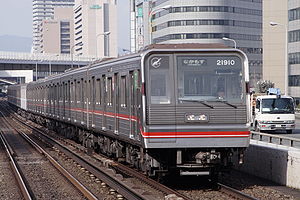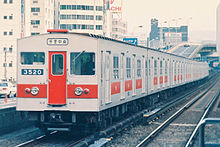- Midōsuji Line
-

Midōsuji Line
Midōsuji Line 21 series train with red lineOverview Type Rapid transit System Osaka Municipal Subway Locale Osaka Termini Esaka
NakamozuStations 20 Line number 1 Operation Opened May 20, 1933 Owner Osaka Municipal Transportation Bureau Depot(s) Nakamozu Rolling stock 10 series, 21 series Technical Line length 24.5 km (15.2 mi) Track length 24.5 km (15.2 mi) Track gauge 1,435 mm (4 ft 8 1⁄2 in) Electrification 750 V DC, third rail Operating speed 70 km/h (43 mph) Route diagram Legend
Connections are of Osaka Municipal Subway lines unless otherwise noted 
5.9 M08 Senri-Chūō 


Osaka Monorail Main Line 




(temporary) Senri-Chūō / Expo Central Gate 
right: Kita-Osaka Kyuko Railway: Expo Line 
3.9 M09 Momoyama-dai 


Kita-Osaka Kyuko Railway Momoyamadai Depot 
1.9 M10 Ryokuchi-kōen 

0.0 M11 Esaka boundary of Osaka Municipal Subway/Kita-Osaka Kyuko Railway 
2.0 M12 Higashi-Mikuni 




Osaka Higashi Line (projected) 






Tōkaidō Shinkansen and Sanyō Shinkansen 






2.9 M13 Shin-Osaka Tōkaidō Main Line (JR Kyoto Line) 













3.6 M14 Nishinakajima-Minamigata 






Hankyu Kyoto Line (Minamikata) 






Hankyu Kobe Line. Takarazuka Line, Kyoto Line (Juso) 






Yodo River 






Nakatsu (Hankyu) 






5.4 M15 Nakatsu 






Tōkaidō Main Line (JR Kyoto Line, JR Kobe Line, JR Takarazuka Line) 






Kita-Umeda 






Hankyu Kobe Line. Takarazuka Line, Kyoto Line (Umeda) 






Osaka: Osaka Loop Line 






6.4 M16 Umeda left: Hanshin Main Line 




Yotsubashi Line Nishi-Umeda (Y11), Tanimachi Line Higashi-Umeda (T20) 




JR Tōzai Line (Kitashinchi) 




Dojima River 




Tosabori River 




Keihan Nakanoshima Line (Ōebashi) 




7.7 M17 Yodoyabashi left: Higobashi / right: Keihan Main Line 




8.6 M18 Hommachi Yotsubashi Line (Y13) 




Chūō Line (C16) 









Nagahori Tsurumi-ryokuchi Line (N15) 




9.6 M19 Shinsaibashi Yotsubashi Line (Yotsubashi: Y14) 









Sennichimae Line (S16) 




Kintetsu Namba Line (Osaka Namba)
Hanshin: Hanshin Namba Line (Osaka Namba)




10.5 M20 Namba Yotsubashi Line (Y15) 




Nankai Main Line, Nankai Kōya Line 




Nankai Main Line, Nankai Kōya Line 


11.7 M21 Daikokuchō Yotsubashi Line (Y16) 









Nankai (Shin-Imamiya); Nankai Line and Kōya Line 


Osaka Loop Line, Kansai Main Line (Yamatoji Line) (Shin-Imamiya) 




Hankai Tramway Hankai Line (Minamikasumichō) 


Sakaisuji Line (K19) 


12.9 M22 Dōbutsuen-mae 







Tanimachi Line (T27) 




13.9 M23 Tennōji Hankai Uemachi Line Tennōji-eki-mae 




Osaka Abenobashi 




Osaka Loop Line 




Kansai Main Line (Yamatoji Line) 









Kintetsu Minami-Osaka Line 




: Tanimachi Line (T29: Fuminosato) 




15.7 M24 Shōwachō 
17.0 M25 Nishitanabe 




Nagai Maintenance Base 







18.3 M26 Nagai JR-W Hanwa Line 


19.5 M27 Abiko 




Abiko Depot abandoned in 1987 
Yamato River 
21.4 M28 Kita-Hanada 
23.0 M29 Shinkanaoka 


Nakamozu Depot 
24.5 M30 Nakamozu 




Nankai Koya Line 


Semboku Rapid Railway The Midōsuji Line (御堂筋線 Midōsuji-sen) is one of the Osaka Municipal Subway lines, of the rapid transit system in Osaka, Japan. Constructed under Midōsuji, a major north-south street, it is the oldest line in the Osaka subway system and the second oldest in Japan, following the Tokyo Metro Ginza Line. Its official name is Rapid Electric Tramway Line No. 1 (高速電気軌道第1号線), while the Osaka Municipal Transportation Bureau refers to it as Osaka City Rapid Railway Line No. 1 (大阪市高速鉄道第1号線), and in MLIT publications it is referred to as Line No. 1 (Midōsuji Line) (1号線(御堂筋線)). On line maps, stations on the Midōsuji Line are indicated with the letter M.
North of Nakatsu it runs above ground in the median of Shin-midōsuji, an elevated freeway.
The section between Senri-chūō and Esaka is owned and operated by Kita-Osaka Kyuko Railway (北大阪急行電鉄 Kita Osaka Dentetsu), but is seamless to the passengers except with respect to fare calculations.
Contents
History
The Midōsuji Line was the first subway line in Osaka and the first government-operated subway line in Japan. Its construction was partly an effort to give work to the many unemployed people in Osaka during the early 1930s. The initial tunnel from Umeda to Shinsaibashi, dug entirely by hand, opened in 1933 after being initially plagued by cave-ins and water leakage caused by the poor composition of the earth below northern Osaka and the equally poor engineering skills of the work crew. The first cars were hauled onto the line by manpower and pack animals from the National Railway tracks near Umeda.[citation needed]
Although the line only operated with single cars at first, its stations were designed from the outset to handle trains of up to eight cars. The line was
gradually extended over the next few decades, completing its current length in 1987, making it the second-longest subway line in Osaka after the Tanimachi Line (excluding the Kita-Osaka Kyūkō Railway extension of the Midōsuji Line).- May 20, 1933 - Umeda (temporary station) - Shinsaibashi (opening).[1] Trains started running in single car formation.
- October 6, 1935 - Umeda Station (present station) opened.
- October 30, 1935 - Shinsaibashi - Namba (opening). Trains started running in 2-car formation.
- April 21, 1938 - Namba - Tennōji (opening). Trains started running in 3-car formation.
- Construction stopped during World War II.
- December 20, 1951 - Tennōji - Shōwachō (opening)
- October 5, 1952 - Shōwachō - Nishitanabe (opening)
- August 1, 1953 - Trains started running in 4-car formation.
- April 1, 1957 - Trains started running in 5-car formation.
- May 1, 1958 - Trains started running in 6-car formation.
- July 1, 1960 - Nishitanabe - Abiko (opening)
- June 1, 1963 - Trains started running in 8-car formation.
- September 1, 1964 - Umeda - Shin-Osaka (opening)
- August 29, 1968 - 30 series EMUs began operation.
- February 24, 1970 - Shin-Osaka - Esaka together with Kita-Osaka Kyuko Railway (Kitakyu) (opening). This section of track was the first in the Midōsuji Line to utilize Automatic Train Control instead of Automatic Train Stop.
- April 1, 1971 - Centralized traffic control introduced.
- February 16, 1976 - 10 series EMUs begin operation.
- April 18, 1987 - Abiko - Nakamozu (opening). Refurbishment of stations to accommodate 9-car trainsets began.
- August 24, 1987, Refurbishment of stations complete, hence all trains were regrouped into 9-car formation.
- May 14, 1991 - 21 series EMUs begin operation.
- 1993 - All trains on the Midōsuji Line are fully air-conditioned after the withdrawal of the 30 series and the Kitakyū 2000 series the same year.
- December 9, 1995 - Refurbishment of stations to accommodate 10-car trainsets began.
- September 1, 1996 - Refurbishment of stations completed, hence all trains were regrouped into 10-car formation.
- December 2011 - 30000 series trains scheduled to enter service.
Stations
For connections and distances, see route diagram.
Station Location M11 Esaka Suita M12 Higashi-Mikuni Yodogawa-ku, Osaka M13 Shin-Osaka M14 Nishinakajima-
MinamigataM15 Nakatsu Kita-ku, Osaka M16 Umeda M17 Yodoyabashi Chūō-ku, Osaka M18 Hommachi M19 Shinsaibashi M20 Namba M21 Daikokuchō Naniwa-ku, Osaka M22 Dōbutsuen-mae Nishinari-ku, Osaka M23 Tennōji Abeno-ku, Osaka M24 Shōwachō M25 Nishitanabe M26 Nagai Sumiyoshi-ku, Osaka M27 Abiko M28 Kitahanada Kita-ku, Sakai M29 Shinkanaoka M30 Nakamozu Rolling stock
Current
- 10 series (from 1976) (transferred from Tanimachi Line)
- 21 series (from 1991)
- Kitakyū 8000 series (from 1987)
Former
- 100 series (1933–1969)
- 200 series (1935–1969)
- 300 series (1938–1969)
- 400 series (1943–1969)
- 500 series (1949–1969)
- 600 series (1951–1969)
- 1000 series (1953–1969)
- 1100 series (1957–1969)
- 1200 series (1958–1969)
- 50 series (1960–1969) (50 series and 30 series trains also ran on the Tanimachi Line.)
- 30 series (1968–1993)
- Kitakyū 7000/8000 series (1970–1988)
- Kitakyū 2000 series (1970–1993)
Future
- 30000 series (from December 2011)
References
- ^ "公営地下鉄在籍車数ビッグ3 大阪市交通局 (One of the big three public subway operators: Osaka Municipal Subway)". Japan Railfan Magazine 49 (576): p.88–99. April 2009.
External links
Categories:- Osaka Municipal Subway
- Rail transport in Osaka Prefecture
- Standard gauge railways in Japan
Wikimedia Foundation. 2010.


